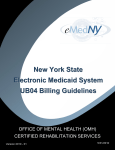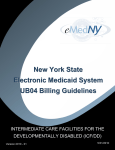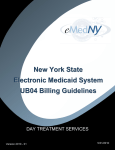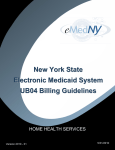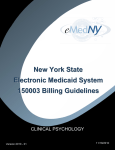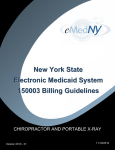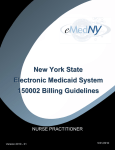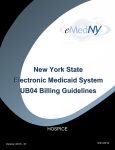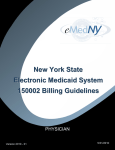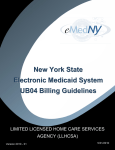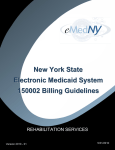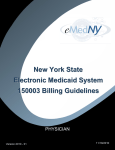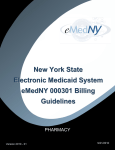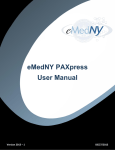Download eMedNY Subsystem User Manual
Transcript
New York State Electronic Medicaid System UB04 Billing Guidelines RESIDENTIAL HEALTH CARE [Type text] Version 2010 - 01 [Type text] [Type text] 5/31/2010 TABLE OF CONTENTS TABLE OF CONTENTS 1. Purpose Statement .......................................................................................................................................... 4 2. Claims Submission ........................................................................................................................................... 5 2.1 Electronic Claims ..................................................................................................................................................... 5 2.2 Paper Claims............................................................................................................................................................ 6 2.2.1 3. General Instructions for Completing Paper Claims .............................................................................................................. 6 2.3 UB-04 Claim Form ................................................................................................................................................... 8 2.4 Residential Health Care Services Billing Instructions .............................................................................................. 8 2.4.1 Instructions for the Submission of Medicare Crossover Claims ........................................................................................... 8 2.4.2 UB-04 Claim Form Field Instructions .................................................................................................................................... 9 Explanation of Paper Remittance Advice Sections........................................................................................ 23 3.1 Section One – Medicaid Check.............................................................................................................................. 24 3.1.1 Medicaid Check Stub Field Descriptions ............................................................................................................................ 25 3.1.2 Medicaid Check Field Descriptions .................................................................................................................................... 25 3.2 3.2.1 3.3 3.3.1 3.4 3.4.1 3.5 Section One – EFT Notification ............................................................................................................................. 26 EFT Notification Page Field Descriptions ............................................................................................................................ 27 Section One – Summout (No Payment) ................................................................................................................ 28 Summout (No Payment) Field Descriptions ....................................................................................................................... 29 Section Two – Provider Notification ..................................................................................................................... 30 Provider Notification Field Descriptions ............................................................................................................................ 31 Section Three – Claim Detail ................................................................................................................................. 32 3.5.1 Claim Detail Page Field Descriptions .................................................................................................................................. 36 3.5.2 Explanation of Claim Detail Columns ................................................................................................................................. 36 3.5.3 Subtotals/Totals/Grand Totals ........................................................................................................................................... 38 3.6 Section Four – Financial Transactions and Accounts Receivable .......................................................................... 40 3.6.1 Financial Transactions ........................................................................................................................................................ 40 3.6.2 Accounts Receivable .......................................................................................................................................................... 42 3.7 Section Five – Edit (Error) Description .................................................................................................................. 44 Appendix A Claim Samples.................................................................................................................................... 45 RESIDENTIAL HEALTH CARE Version 2010 - 01 5/31/2010 Page 2 of 47 CLAIMS SUBMISSION For eMedNY Billing Guideline questions, please contact the eMedNY Call Center 1-800-343-9000. RESIDENTIAL HEALTH CARE Version 2010 - 01 5/31/2010 Page 3 of 47 PURPOSE STATEMENT 1. Purpose Statement The purpose of this document is to assist the provider community in understanding and complying with the New York State Medicaid (NYS Medicaid) requirements and expectations for: Billing and submitting claims. Interpreting and using the information returned in the Medicaid Remittance Advice. This document is customized for Residential Health Care providers and should be used by the provider as an instructional, as well as a reference tool. For providers new to NYS Medicaid, it is required to read the All Providers General Billing Guideline Information available at www.emedny.org by clicking on the link to the webpage as follows: Information for All Providers. RESIDENTIAL HEALTH CARE Version 2010 - 01 5/31/2010 Page 4 of 47 CLAIMS SUBMISSION 2. Claims Submission Residential Health Care providers can submit their claims to NYS Medicaid in electronic or paper formats. Providers are required to submit an Electronic/Paper Transmitter Identification Number (ETIN) Application and Certification Statement before submitting claims to NYS Medicaid. Certification Statements remain in effect and apply to all claims until superseded by another properly executed Certification Statement. Providers will be asked to update their Certification Statement on an annual basis. Providers will be provided with renewal information when their Certification Statement is near expiration. Information about these requirements is available at www.emedny.org by clicking on the link to the webpage as follows: Information for All Providers. 2.1 Electronic Claims Pursuant to the Health Insurance Portability and Accountability Act (HIPAA), Public Law 104-191, which was signed into law August 12, 1996, the NYS Medicaid Program adopted the HIPAA-compliant transactions as the sole acceptable format for electronic claim submission, effective November 2003. Residential Health Care providers who choose to submit their Medicaid claims electronically are required to use the HIPAA 837 Institutional (837I) transaction. Direct billers should also refer to the sources listed below to comply with the NYS Medicaid requirements. HIPAA 837I Implementation Guide (IG) explains the proper use of the 837I standards and program specifications. This document is available at www.wpc-edi.com/hipaa. NYS Medicaid 837I Companion Guide (CG) is a subset of the IG, which provides instructions for the specific requirements of NYS Medicaid for the 837I. This document is available at www.emedny.org by clicking on the link to the web page as follows: Companion Guides and Sample Files. NYS Medicaid Technical Supplementary Companion Guide provides technical information needed to successfully transmit and receive electronic data. Some of the topics put forth in this CG are testing requirements, error report information, and communication specifications. This document is available at www.emedny.org by clicking on the link to the web page as follows: Companion Guides and Sample Files. Further information about electronic claim pre-requirements is available at www.emedny.org by clicking on the link to the webpage as follows: Information for All Providers. RESIDENTIAL HEALTH CARE Version 2010 - 01 5/31/2010 Page 5 of 47 CLAIMS SUBMISSION 2.2 Paper Claims Residential Health Care providers who choose to submit their claims on paper forms must use the Centers for Medicare and Medicaid Services (CMS) standard UB-04 claim form. To view a sample Residential Health Care UB-04 claim form, see Appendix A. The displayed claim form is a sample and the information it contains is for illustration purposes only. An Electronic Transmission Identification Number (ETIN) and a Certification Statement are required to submit paper claims. Providers who have a valid ETIN for the submission of electronic claims do not need an additional ETIN for paper submissions. The ETIN and the associated certification qualify the provider to submit claims in both electronic and paper formats. Information about these requirements is available at www.emedny.org by clicking on the link to the webpage as follows: Information for All Providers. 2.2.1 General Instructions for Completing Paper Claims Since the information entered on the claim form is captured via an automated data collection process (imaging), it is imperative that it be legible and placed appropriately in the required fields. The following guidelines will help ensure the accuracy of the imaging output: All information should be typed or printed. Alpha characters (letters) should be capitalized. Numbers should be written as close to the example below in Exhibit 2.2.1-1 as possible: Exhibit 2.2.1-1 Circles (the letter O, the number 0) must be closed. Avoid unfinished characters. See the example in Exhibit 2.2.1-2. Exhibit 2.2.1-2 When typing or printing, stay within the box provided; ensure that no characters (letters or numbers) touch the claim form lines. See the example in Exhibit 2.2.1-3. RESIDENTIAL HEALTH CARE Version 2010 - 01 5/31/2010 Page 6 of 47 CLAIMS SUBMISSION Exhibit 2.2.1-3 Characters should not touch each other as seen in Exhibit 2.2.1-4. Exhibit 2.2.1-4 Do not write between lines. Do not use arrows or quotation marks to duplicate information. Do not use the dollar sign ($) to indicate dollar amounts; do not use commas to separate thousands. For example, three thousand should be entered as 3000, not as 3,000. For writing, it is best to use a felt tip pen with a fine point. Avoid ballpoint pens that skip; do not use pencils, highlighters, or markers. Only blue or black ink is acceptable. If filling in information through a computer, ensure that all information is aligned properly, and that the printer ink is dark enough to provide clear legibility. Do not submit claim forms with corrections, such as information written over correction fluid or crossed out information. If mistakes are made, a new form should be used. Separate forms using perforations; do not cut the edges. Do not fold the claim forms. Do not use adhesive labels (for example for address); do not place stickers on the form. Do not write or use staples on the bar-code area. The address for submitting claim forms is: COMPUTER SCIENCES CORPORATION P.O. Box 4601 Rensselaer, NY 12144-4601 RESIDENTIAL HEALTH CARE Version 2010 - 01 5/31/2010 Page 7 of 47 CLAIMS SUBMISSION 2.3 UB-04 Claim Form To view a sample Residential Health Care UB-04 claim form, see Appendix A. The displayed claim form is a sample and the information it contains is for illustration purposes only. The UB-04 CMS-1450 is a CMS standard form; therefore CSC does not supply it. The form can be obtained from any of the national suppliers. The UB-04 Manual (National Uniform Billing Data Element Specifications as Developed by the National Uniform Billing Committee – Current Revision) should be used in conjunction with this Provider Billing Guideline as a reference guide for the preparation of claims to be submitted to NYS Medicaid. The UB-04 manual is available at www.nubc.org. Form Locators in this manual for which no instruction has been provided have no Medicaid application. These Form Locators are ignored when the claim is processed. 2.4 Residential Health Care Services Billing Instructions This subsection of the Billing Guidelines covers the specific NYS Medicaid billing requirements for Residential Health Care providers. Although the instructions that follow are based on the UB-04 paper claim form, they are also intended as a guideline for electronic billers to find out what information they need to provide in their claims, in addition to the HIPAA Companion Guides which are available at www.emedny.org by clicking on the link to the webpage as follows: eMedNY Companion Guides and Sample Files. It is important that providers adhere to the instructions outlined below. Claims that do not conform to the eMedNY requirements as described throughout this document may be rejected, pended, or denied. 2.4.1 Instructions for the Submission of Medicare Crossover Claims This subsection is intended to familiarize the provider with the submission of crossover claims. Providers can bill claims for Medicare/Medicaid patients to Medicare. Medicare will then reimburse its portion to the provider and the provider’s Medicare remittance will indicate that the claim will be crossed over to Medicaid. Claims for services not covered by Medicare should continue to be submitted directly to Medicaid as policy allows. Also, Medicare Part-C (Medicare Managed Care) and Medicare Part-D claims are not part of this process. Providers are urged to review their Medicare remittances for crossovers beginning December 1, 2009, to determine whether their claims have been crossed over to Medicaid for processing. Any claim that was indicated by Medicare as a crossover should not be submitted to Medicaid as a separate claim. If the Medicare remittance does not indicate the claim has been crossed over to Medicaid, the provider should submit the claim directly to Medicaid. Claims that are denied by Medicare will not be crossed over. Medicaid will deny claims that are crossed over without a Patient Responsibility. RESIDENTIAL HEALTH CARE Version 2010 - 01 5/31/2010 Page 8 of 47 CLAIMS SUBMISSION If a separate claim is submitted directly by the provider to Medicaid for a dual eligible recipient and the claim is paid before the Medicare crossover claim, both claims will be paid. The eMedNY system automatically voids the provider submitted claim in this scenario. Providers may submit adjustments to Medicaid for their crossover claims, because they are processed as a regular adjustment. Electronic remittances from Medicaid for crossover claims will be sent to the default ETIN when the default is set to electronic. If there is no default ETIN, the crossover claims will be reported on a paper remittance. The ETIN application is available at www.emedny.org by clicking on the link to the webpage as follows: Provider Enrollment Forms. NOTE: For crossover claims, the Locator Code will default to 003 if zip+4 does not match information in the provider’s Medicaid file. 2.4.2 UB-04 Claim Form Field Instructions Provider Name, Address, and Telephone Number (Form Locator 1) Enter the billing provider’s name and address, using the following rules for submitting the ZIP code: Paper claim submissions Enter the five-digit ZIP code or the ZIP plus four. Electronic claim submissions Enter the nine-digit ZIP code. The Locator Code will default to 003 if the nine digit ZIP code does not match information in the provider’s Medicaid file. NOTE: It is the responsibility of the provider to notify Medicaid of any change of address or other pertinent information within 15 days of the change. For information on where to direct address change requests please refer to Information for All Providers, Inquiry section which can be found at www.emedny.org by clicking on the link to the webpage as follows: Residential Health Manual. Patient Control Number (Form Locator 3a) For record-keeping purposes, the provider may choose to identify a patient by using an account/patient control number. This field can accommodate up to 30 alphanumeric characters. If an account/patient control number is indicated on the claim form, the first 20 characters will be returned on the paper Remittance Advice. Using an account/patient control number can be helpful for locating accounts when there is a question on patient identification. RESIDENTIAL HEALTH CARE Version 2010 - 01 5/31/2010 Page 9 of 47 CLAIMS SUBMISSION Type of Bill (Form Locator 4) Completion of this field is required for all provider types. All entries in this field must contain three digits. Each digit identifies a different category as follows: 1st Digit – Type of Facility 2nd Digit – Bill Classification 3rd Digit – Frequency Type of Facility Using the UB-04 Manual, Form Locator 4, Type of Facility category, select the code that best describes the facility type. For SNF-Free Standing only, use Type of Facility Code 2 (Skilled Nursing). Bill Classification Using the UB-04 Manual, Form Locator 4, Bill Classification category, select the code that best describes the type of service being claimed. Frequency - Adjustment/Void Code New York State Medicaid uses the third position of this field only to identify whether the claim is an original, a replacement (adjustment) or a void. If submitting an original claim, enter the value 0 in the third position of this field as in Exhibit 2.4.2-1. Exhibit 2.4.2-1 If submitting an adjustment (replacement) to a previously paid claim, enter the value 7 in the third position of this field as in Exhibit 2.4.2-2. Exhibit 2.4.2-2 If submitting a void to a previously paid claim, enter the value 8 in the third position of this field as in Exhibit 2.4.2-3. Exhibit 2.4.2-3 RESIDENTIAL HEALTH CARE Version 2010 - 01 5/31/2010 Page 10 of 47 CLAIMS SUBMISSION Statement Covers Period From/Through (Form Locator 6) When billing for one date of service, enter the same date in the FROM and THROUGH boxes or leave the THROUGH box blank. When billing for multiple dates of service, enter the first service date of the billing period in the FROM box and the last service date in the THROUGH box. The first and last service dates must be in the same calendar month. Dates must be entered in the format MMDDYYYY. Non-Occupant Care In order to properly identify each date of service, the FROM and THROUGH dates must be inclusive. All services included in the FROM and THROUGH fields must indicate the same number of hours and must be for consecutive days within the same month. If services rendered do not have a consistent number of hours scheduled for any given period, then each service day must be billed separately. NOTES: Claims must be submitted within 90 days of the date of service entered in this field unless acceptable circumstances for the delay can be documented. Information about billing claims over 90 days or two years from the Date of Service is available in the All Providers General Billing Guideline Information section available at www.emedny.org by clicking on the link to the webpage as follows: Information for All Providers. Do not include full days covered by Medicare or other third-party insurers as part of the period of service. A separate claim must be completed if the period of service includes therapeutic or hospital leave days. Patient Name (Form Locator 8, line b) Enter the patient’s last name followed by the first name. This information may be obtained from the Client’s (Patient’s) Common Benefit ID Card. Birthdate (Form Locator 10) Enter the patient’s birth date. This information may be obtained from the Client’s (Patient’s) Common Benefit ID Card. The birth date must be in the format MMDDYYYY. See the example in Exhibit 2.4.2-4 that follows. Exhibit 2.4.2-4 RESIDENTIAL HEALTH CARE Version 2010 - 01 5/31/2010 Page 11 of 47 CLAIMS SUBMISSION Sex (Form Locator 11) Enter M for male or F for female to indicate the patient’s sex. This information may be obtained from the Client’s (Patient’s) Common Benefit ID Card. Admission (Form Locators 12-15) Leave all fields blank. Stat [Patient Status] (Form Locator 17) This field is used to indicate the specific condition or status of the patient as of the last date of service indicated in Form Locator 6. Select the appropriate code (except for 43 and 65) from the UB-04 Manual. Condition Codes (Form Locators18–28) Leave all fields blank. Occurrence Code/Date (Form Locators 31–34) Leave all fields blank. Value Codes (Form Locators 39-41) NYS Medicaid uses Value Codes to report the following information: Locator Code (required: see notes for conditions) Rate Code (required) Patient Participation (only if applicable) Other Insurance Payment (only if applicable) Medicaid Covered Days (only if applicable) Medicaid Non-Covered Days (only if applicable) Medicare Co-Insurance Days (only if applicable) Value Codes have two components: Code and Amount. The Code component is used to indicate the type of information reported. The Amount component is used to enter the information itself. Both components are required for each entry. Locator Code - Value Code 61 For electronic claims, leave this field blank. The Locator Code will be defaulted to 003 if the nine digit ZIP Code submitted on the claim does not match what is on file. For paper claims, enter the locator code assigned by NYS Medicaid. RESIDENTIAL HEALTH CARE Version 2010 - 01 5/31/2010 Page 12 of 47 CLAIMS SUBMISSION Locator codes are assigned to the provider for each service address registered at the time of enrollment in the Medicaid program or at anytime, afterwards, that a new location is added. Value Code Code 61 should be used to indicate that a Locator Code is entered under Amount. Value Amount Entry must be three digits and must be placed to the left of the dollars/cents delimiter. Locator codes 001 and 002 are for administrative use only and are not to be entered in this field. The entry may be 003 or a higher locator code. Enter the locator code that corresponds to the address where the service was performed. The example in Exhibit 2.4.2-5 illustrates a correct Locator Code entry. Exhibit 2.4.2-5 NOTE: The provider is reminded of the obligation to notify Medicaid of all service locations as well as changes to any of them. For information on where to direct locator code updates, please refer to Information for All Providers, Inquiry section located at www.emedny.org by clicking on the link to the webpage as follows: Residential Health Manual. Rate Code - Value Code 24 Rates are established by the Department of Health and other State agencies. At the time of enrollment in Medicaid, providers receive notification of the rate codes and rate amounts assigned to their category of service. Any time that rate codes or amounts change, providers also receive notification from the Department of Health. Value Code Code 24 should be used to indicate that a rate code is entered under Amount. Value Amount Enter the rate code that applies to the service rendered. The four-digit rate code must be entered to the left of the dollars/cents delimiter. The example in Exhibit 2.4.2-6 illustrates a correct rate code entry. RESIDENTIAL HEALTH CARE Version 2010 - 01 5/31/2010 Page 13 of 47 CLAIMS SUBMISSION Exhibit 2.4.2-6 In order for claims to be processed correctly, it is essential that the correct Rate Code be used for each patient. Rate Codes vary depending on the facility type and the patient’s additional coverage. Select the appropriate Rate Code according to the following list: Free-Standing Nursing Facilities Use Code 3810 when billing for Medicaid patients who either don’t have Medicare coverage or have only Medicare Part A coverage. Use Code 3812 when billing for patients who either have Medicare Part A and B coverage or have only Medicare Part B coverage. Use code 3838 when billing for patients who have only Medicare Part D coverage. Use code 3839 when billing for patients who have Medicare Part B and Part D coverage. Hospital-Based Nursing Facilities Use Rate Code 2863 when billing for Medicaid patients who either don’t have Medicare coverage or have only Part A coverage. Use Rate Code 2862 when billing for patients who either have Medicare Part A and B coverage or have only Medicare Part B coverage. Use code 3838 when billing for patients who have only Medicare Part D coverage. Use code 3839 when billing for patients who have Medicare Part B and Part D coverage. NOTES: The Medicare coverage information should be obtained from the eMedNY Eligibility Verification System (MEVS). Claims for bed reservations may be billed to the higher non-Medicare Part B rate. Free-Standing Day Care Services Use Rate Code 3800. Hospital-Based Day Care Services Use Rate Code 3800. RESIDENTIAL HEALTH CARE Version 2010 - 01 5/31/2010 Page 14 of 47 CLAIMS SUBMISSION Patient Participation (NAMI) - Value Code 23 Value Code Code 23 should be used to indicate that the patient’s Net Available Monthly Income (NAMI) amount is entered under Amount. Value Amount Enter the NAMI amount approved by the local Social Services agency as the patient’s monthly budget. In cases where the patient’s budget has increased, the new amount, rather than the current budgeted amount, should be entered. If billing occurs more than once a month, enter the full NAMI amount on the first claim submitted for the month as illustrated in Exhibit 2.4.2-7: Exhibit 2.4.2-7 NOTE: For retroactive NAMI changes, an adjustment to the previously paid claim needs to be submitted. These adjustments can only be submitted when approval for a budget change has been received from the LDSS. Other Insurance Payment – Value Code A3 or B3 If the patient has insurance other than Medicare, it is the responsibility of the provider to determine whether the service being billed for is covered by the patient's Other Insurance carrier. If the service is covered or if the provider does not know if the service is covered, the provider must first submit a claim to the Other Insurance carrier, as Medicaid is always the payer of last resort. Value Code If applicable, code A3 or B3 should be used to indicate that the amount paid by an insurance carrier other than Medicare is entered under Amount. The line (A or B) assigned to the Insurance Carrier in Form Locator 50 determines the choice of codes A3 or B3. Value Amount Enter the actual amount paid by the other insurance carrier. If the other insurance carrier denied payment enter 0.00. Proof of denial of payment must be maintained in the patient’s billing record. Zeroes must also be entered in this field if any of the following situations apply: Prior to billing the insurance company, the provider knows that the service will not be covered because: RESIDENTIAL HEALTH CARE Version 2010 - 01 5/31/2010 Page 15 of 47 CLAIMS SUBMISSION The provider has had a previous denial for payment for the service from the particular insurance policy. However, the provider should be aware that the service should be billed if the insurance policy changes. Proof of denials must be maintained in the patient’s billing record. Prior claims denied due to deductibles not being met are not to be counted as denials for subsequent billings. In very limited situations the Local Department of Social Services (LDSS) has advised the provider to zero-fill the Other Insurance payment for the same type of service. This communication should be documented in the client's billing record. The provider bills the insurance company and receives a rejection because: The service is not covered; or The deductible has not been met. The provider cannot directly bill the insurance carrier and the policyholder is either unavailable or uncooperative in submitting claims to the insurance company. In these cases the LDSS must be notified prior to zero-filling. The LDSS has subrogation rights enabling it to complete claim forms on behalf of uncooperative policyholders who do not pay the provider for the services. The LDSS can direct the insurance company to pay the provider directly for the service whether or not the provider participates with the insurance plan. The provider should contact the third-party worker in the LDSS whenever he/she encounters policyholders who are uncooperative in paying for covered services received by their dependents who are on Medicaid. In other cases providers will be instructed to zero-fill the Other Insurance payment in the Medicaid claim and the LDSS will retroactively pursue the third-party resource. The patient or an absent parent collects the insurance benefits and fails to submit payment to the provider. The LDSS must be notified so that sanctions and/or legal action can be brought against the patient or absent parent. The provider is instructed to zero-fill by the LDSS for circumstances not listed above. The example in Exhibit 2.4.2-8 illustrates a correct Other Insurance Payment entry. Exhibit 2.4.2.-8 Medicaid Covered Days – Value Code 80 Value Code Code 80 should be used to indicate the total number of days that are covered by Medicaid. If only co-insurance days are claimed, do not report code 80. RESIDENTIAL HEALTH CARE Version 2010 - 01 5/31/2010 Page 16 of 47 CLAIMS SUBMISSION Value Amount Enter the actual amount of days covered by Medicaid. The sum of Medicaid Full covered days, Medicaid non-covered days and Medicare co-insurance days must correspond to the Statement Covers Period in Form Locator 6 and should not reflect the day of discharge. The Covered Days must be entered to the left of the dollars/cents delimiter. The example in Exhibit 2.4.2-9 illustrates a correct Medicaid Covered Days entry. Exhibit 2.4.2-9 Medicaid Non-Covered Days – Value Code 81 Value Code Code 81 should be used to indicate the total number of full days that are not reimbursable by Medicaid or any other third party. This does not include full days covered by Medicare or other third-party insurers. Value Amount Enter the actual number of days non-covered by Medicaid. The sum of Medicaid full covered days, Medicaid noncovered days and Medicare co-insurance days must correspond to the Statement Covers Period in Form Locator 6 and should not reflect the day of discharge. The Non-Covered Days must be entered to the left of the dollars/cents delimiter. NOTE: For non-resident health care patients, non-covered days are those days occurring within the service period on which health care services were not rendered, for example, weekends. The example in Exhibit 2.4.2-10 illustrates a correct Medicaid Non-Covered Days entry. Exhibit 2.4.2-10 RESIDENTIAL HEALTH CARE Version 2010 - 01 5/31/2010 Page 17 of 47 CLAIMS SUBMISSION Medicare Co-Insurance Days – Value Code 82 Value Code Code 82 should be used to indicate the total number of Medicare co-insurance days claimed during the service period. Value Amount Enter the actual number of Medicare co-insurance days. The sum of Medicaid full covered days, Medicaid non-covered days and Medicare co-insurance days must correspond to the Statement Covers Period in Form Locator 6 and should not reflect the day of discharge. The Co-Insurance Days must be entered to the left of the dollars/cents delimiter. The example in Exhibit 2.4.2-11 illustrates a correct Medicare Co-Insurance Days entry. Exhibit 2.4.2-11 Rev. Cd. [Revenue Code] (Form Locator 42) Revenue Codes identify specific accommodations, ancillary services, or billing calculations. NYS Medicaid uses Revenue Codes to identify the following information: Total Charges Title XIX Days – Hospital Leave Title XIX Days – Therapeutic Leave Total Charges Use Revenue Code 0001 to indicate that total charges are entered in Form Locator 47. Hospital Leave The patient was hospitalized during the billing period and bed retention was involved. If bed retention for hospitalization was not involved, hospital leave is not applicable. Please refer to the Residential Health Care Manual, Policy Guidelines section for Bed Reservation information. If applicable, use Revenue Code 0185 to indicate that the number of Hospital Leave days is entered in Form Locator 46. Hospital Leave must not be claimed together with regular billing; these claims must be submitted on a separate form. RESIDENTIAL HEALTH CARE Version 2010 - 01 5/31/2010 Page 18 of 47 CLAIMS SUBMISSION Therapeutic Leave These are overnight absences that include leave for personal reasons or to participate in medically acceptable therapeutic or rehabilitative plans of care. Please refer to the Residential Health Care Manual, Policy Guidelines section for Bed Reservation information. If applicable, use Revenue Code 0183 to indicate that the number of Therapeutic Leave days is entered in Form Locator 46. Therapeutic Leave must not be claimed together with regular billing; these claims must be submitted on a separate form. Serv. Units (Form Locator 46) If Revenue Code 0185 (Hospital Leave) was used in Form Locator 42, enter the total number of Hospital Leave days on the same line where the Revenue Code appears. The number of units entered in this field must match the entry in Form Locators 39 – 41, Value Code 80, “Covered Days”. If Revenue Code 0183 (Therapeutic Leave) was used in Form Locator 42, enter the total number of Therapeutic Leave days on the same line where the Revenue Code appears. The number of units entered in this field must match the entry in Form Locators 39 – 41, Value Code 80, “Covered Days”. Total Charges (Form Locator 47) Enter the total amount charged for the service(s) rendered. This is computed by multiplying the total number of full days times the per diem rate. The charged amount must be entered on the line corresponding to Revenue Code 0001 and both sections of the field (dollars and cents) must be completed; if the charges contain no cents, enter 00 in the cents box. Exhibit 2.4.2-12 If Therapeutic Leave or Hospital Leave units were entered in Form Locator 46, enter the charges for that line in this field as well. Exhibit 2.4.2-13 RESIDENTIAL HEALTH CARE Version 2010 - 01 5/31/2010 Page 19 of 47 CLAIMS SUBMISSION Payer Name (Form Locator 50 A, B, C) This field identifies the payer(s) responsible for the claim payment. The field lines (A, B, and C) are devised to indicate primary (A), secondary (B), and tertiary (C) responsibility for claim payment. For NYS Medicaid billing, payers are classified into three main categories: Medicare, Commercial (any insurance other than Medicare), and Medicaid. Medicaid is always the payer of last resort. Complete this field in accordance with the following instructions. Direct Medicaid Claim—No Third Party Involved Enter the word Medicaid on line A of this field. Leave lines B and C blank. Medicaid/Third Party (Other Than Medicare) Claim Enter the name of the Other Insurance Carrier on line A of this field. Enter the word Medicaid on line B of this field. Leave line C blank. NPI (Form Locator 56) Enter the provider’s 10-digit National Provider Identifier (NPI). Other Prv ID [Other Provider ID] (Form Locator 57) Leave this field blank. Insured’s Unique ID (Form Locator 60) Enter the patient's ID number (Client ID number). This information may be obtained from the Client’s (Patient’s) Common Benefit ID Card. Medicaid Client ID numbers are assigned by the State of New York and are composed of eight characters in the format AANNNNNA, where A = alpha character and N = numeric character. For example: AB12345C The Medicaid Client ID should be entered on the same line (A, B, or C) that matches the line assigned to Medicaid in Form Locators 50 and 57. If the patient’s Medicaid Client ID number is entered on lines B or C, the lines above the Medicaid ID number must contain either the patient’s ID for the other payer(s) or the word NONE. Treatment Authorization Codes (Form Locator 63) If the service requires Prior Approval, enter the 11-digit Prior Approval number here. The Prior Approval must be entered on the line (A, B, or C) that corresponds to the line assigned to Medicaid in Form Locators 50 and 57. If the Prior Approval number is entered on lines B or C, the word NONE must be written in the line(s) above the Prior Approval line. Leave this field blank if the service does not require Prior Approval. RESIDENTIAL HEALTH CARE Version 2010 - 01 5/31/2010 Page 20 of 47 CLAIMS SUBMISSION NOTE: For information regarding how to obtain Prior Approval/Authorization for specific services, please refer to www.emedny.org by clicking on the link to the webpage as follows: Residential Health Manual. Document Control Number (Form Locators 64 A, B, C) Leave this field blank when submitting an original claim or a resubmission of a denied claim. If submitting an Adjustment (Replacement) or a Void to a previously paid claim, this field must be used to enter the Transaction Control Number (TCN) assigned to the claim to be adjusted or voided. The TCN is the claim identifier and is listed in the Remittance Advice. If a TCN is entered in this field, the third position of Form Locator 4, Type of Bill, must be 7 or 8. The TCN must be entered in the line (A, B, or C) that matches the line assigned to Medicaid in Form Locators 50 and 57. If the TCN is entered in lines B or C, the word NONE must be written on the line(s) above the TCN line. Adjustments An adjustment is submitted to correct one or more fields of a previously paid claim. Any field, except the Provider ID number or the Patient’s Medicaid ID number, can be adjusted. The adjustment must be submitted in a new claim form (copy of the original form is unacceptable) and all applicable fields must be completed. An adjustment is identified by the value 7 in the third position of Form Locator 4, Type of Bill, and the claim to be adjusted is identified by the TCN entered in this field (Form Locator 64). Adjustments cause the correction of the adjusted information in the claim history records as well as the cancellation of the original claim payment and the re-pricing of the claim based on the adjusted information. Voids A void is submitted to nullify a paid claim. The void must be submitted in a new claim form (copy of the original form is unacceptable) and all applicable fields must be completed. A void is identified by the value 8 in the third position of Form Locator 4, Type of Bill, and the claim to be voided is identified by the TCN entered in this field (Form Locator 64). Voids cause the cancellation of the original claim history records and payment. Untitled [Principal Diagnosis Code] (Form Locator 67) This field must be completed upon admission of a patient, if there is any change in the diagnosis (including a diagnosis change for a patient on bed reservation), and when a patient is discharged. Leave blank if the entry in Form Locator 17 (Patient Status) indicates that the patient is still a patient or is on therapeutic leave. Using the International Classification of Diseases, Ninth Edition, Clinical Modification (ICD-9-CM) coding system, enter the appropriate code that describes the main condition or symptom of the patient. The ICD-9-CM code must be entered exactly as it is listed in the manual. The remaining Form Locators labeled A – Q may be used to indicate secondary diagnosis information. RESIDENTIAL HEALTH CARE Version 2010 - 01 5/31/2010 Page 21 of 47 CLAIMS SUBMISSION NOTE: Three-digit and four-digit diagnosis codes will be accepted only when the category has no subcategories. Principal Procedure (Form Locator 74) Leave this field blank. Other (Form Locator 78) NYS Medicaid uses this field to report the Referring/Destination/Previous Provider. Complete this field only if an admission or a discharge (other than to home or self care) occurred during the service period covered by this statement (Form Locator 6). If no admission or discharge occurred or if the patient was discharged to home or self-care leave this field blank. For an admission Enter the NPI of the referring practitioner who determined that residential care was appropriate. NOTE: If the patient is admitted from home, enter the NPI of the physician who last examined the patient and determined that ICF/DD nursing home care was appropriate. See instructions for entering an NPI below. For a discharge Enter the NPI of the practitioner who made the discharge determination. Instructions for entering an NPI Enter the code “DN” in the unlabeled field between the words “OTHER” and “NPI” to indicate the 10-digit NPI of the provider is entered in the box labeled “NPI”. On the line below the ID numbers, enter the last name and first name of the provider. See the example in Exhibit 2.4.214. Exhibit 2.4.2-14 RESIDENTIAL HEALTH CARE Version 2010 - 01 5/31/2010 Page 22 of 47 REMITTANCE ADVICE 3. Explanation of Paper Remittance Advice Sections This Section present a sample of each section of the remittance advice for Residential Health providers followed by an explanation of the elements contained in the section. The information displayed in the remittance advice samples is for illustration purposes only. The following information applies to a remittance advice with the default sort pattern. General Remittance Advice Information is available in the All Providers General Billing Guideline Information section available at www.emedny.org by clicking on the link to the webpage as follows: Information for All Providers. The remittance advice is composed of five sections. Section One may be one of the following: Medicaid Check Notice of Electronic Funds Transfer Summout (no claims paid) Section Two: Provider Notification (special messages) Section Three: Claim Detail Section Four: Financial Transactions (recoupments) Accounts Receivable (cumulative financial information) Section Five: Edit (Error) Description RESIDENTIAL HEALTH CARE Version 2010 - 01 5/31/2010 Page 23 of 47 REMITTANCE ADVICE 3.1 Section One – Medicaid Check For providers who have selected to be paid by check, a Medicaid check is issued when the provider has claims approved for the cycle and the approved amount is greater than the recoupments, if any, scheduled for the cycle. This section contains the check stub and the actual Medicaid check (payment). Exhibit 3.1-1 RESIDENTIAL HEALTH CARE Version 2010 - 01 5/31/2010 Page 24 of 47 REMITTANCE ADVICE 3.1.1 Medicaid Check Stub Field Descriptions Upper Left Corner Provider’s Name (as recorded in the Medicaid files) Upper Right Corner Date on which the remittance advice was issued Remittance Number PROV ID: This field will contain the Medicaid Provider ID and the NPI Center Medicaid Provider ID/NPI/Date Provider’s Name/Address 3.1.2 Medicaid Check Field Descriptions Left Side Table Date on which the check was issued Remittance Number Provider ID No.: This field will contain the Medicaid Provider ID and the NPI Provider’s Name/Address Right Side Dollar amount. This amount must equal the Net Total Paid Amount under the Grand Total subsection plus the total sum of the Financial Transaction section. RESIDENTIAL HEALTH CARE Version 2010 - 01 5/31/2010 Page 25 of 47 REMITTANCE ADVICE 3.2 Section One – EFT Notification For providers who have selected electronic funds transfer (or direct deposit), an EFT transaction is processed when the provider has claims approved during the cycle and the approved amount is greater than the recoupments, if any, scheduled for the cycle. This section indicates the amount of the EFT. Exhibit 3.2-1 RESIDENTIAL HEALTH CARE Version 2010 - 01 5/31/2010 Page 26 of 47 REMITTANCE ADVICE 3.2.1 EFT Notification Page Field Descriptions Upper Left Corner Provider’s name (as recorded in the Medicaid files) Upper Right Corner Date on which the remittance advice was issued Remittance number PROV ID: This field will contain the Medicaid Provider ID and the NPI Center Medicaid Provider ID/NPI/Date Provider’s Name/Address Provider’s Name – Amount transferred to the provider’s account. This amount must equal the Net Total Paid Amount under the Grand Total subsection plus the total sum of the Financial Transaction section. RESIDENTIAL HEALTH CARE Version 2010 - 01 5/31/2010 Page 27 of 47 REMITTANCE ADVICE 3.3 Section One – Summout (No Payment) A summout is produced when the provider has no positive total payment for the cycle and, therefore, there is no disbursement of moneys. Exhibit 3.3-1 RESIDENTIAL HEALTH CARE Version 2010 - 01 5/31/2010 Page 28 of 47 REMITTANCE ADVICE 3.3.1 Summout (No Payment) Field Descriptions Upper Left Corner Provider’s Name (as recorded in the Medicaid files) Upper Right Corner Date on which the remittance advice was issued Remittance Number PROV ID: This field will contain the Medicaid Provider ID and the NPI Center Notification that no payment was made for the cycle (no claims were approved) Provider Name and Address RESIDENTIAL HEALTH CARE Version 2010 - 01 5/31/2010 Page 29 of 47 REMITTANCE ADVICE 3.4 Section Two – Provider Notification This section is used to communicate important messages to providers. Exhibit 3.4-1 RESIDENTIAL HEALTH CARE Version 2010 - 01 5/31/2010 Page 30 of 47 REMITTANCE ADVICE 3.4.1 Provider Notification Field Descriptions Upper Left Corner Provider’s Name (as recorded in the Medicaid files) Upper Right Corner Remittance page number Date on which the remittance advice was issued Cycle Number ETIN (not applicable) Name of section: PROVIDER NOTIFICATION PROV ID: This field will contain the Medicaid Provider ID and the NPI Remittance number Center Message text RESIDENTIAL HEALTH CARE Version 2010 - 01 5/31/2010 Page 31 of 47 REMITTANCE ADVICE 3.5 Section Three – Claim Detail This section provides a listing of all new claims that were processed during the specific cycle plus claims that were previously pended and denied during the specific cycle. This section may also contain claims that pended previously. Exhibit 3.5-1 RESIDENTIAL HEALTH CARE Version 2010 - 01 5/31/2010 Page 32 of 47 REMITTANCE ADVICE Exhibit 3.5-2 RESIDENTIAL HEALTH CARE Version 2010 - 01 5/31/2010 Page 33 of 47 REMITTANCE ADVICE Exhibit 3.5-3 RESIDENTIAL HEALTH CARE Version 2010 - 01 5/31/2010 Page 34 of 47 REMITTANCE ADVICE Exhibit 3.5-4 RESIDENTIAL HEALTH CARE Version 2010 - 01 5/31/2010 Page 35 of 47 REMITTANCE ADVICE 3.5.1 Claim Detail Page Field Descriptions Upper Left Corner Provider’s Name/Address Upper Right Corner Remittance page number Date: The date on which the remittance advice was issued Cycle number: The cycle number should be used when calling the eMedNY Call Center with questions about specific processed claims or payments. ETIN (not applicable) Provider Service Classification: NURSING HOME PROV ID: This field will contain the Medicaid Provider ID and the NPI Remittance Number 3.5.2 Explanation of Claim Detail Columns Client Name/ID Number This column indicates the last name of the patient (first line) and the Medicaid Client ID (second line). If an invalid Medicaid Client ID was entered in the claim form, the ID will be listed as it was submitted but no name will appear in this column. TCN/Patient Account Number The TCN (first line) is a unique identifier assigned to each claim that is processed. If a Patient Account Number was entered in the claim form, that number (up to 20 characters) will appear under this column (second line). Service Dates – From/Through The first date of service covered by the claim (From date) appears on the first line; the last date of service (Through date) appears on the second line. Rate Code The four-digit rate code that was entered in the claim form appears under this column. RESIDENTIAL HEALTH CARE Version 2010 - 01 5/31/2010 Page 36 of 47 REMITTANCE ADVICE Reported/Calculated Days This column has two sub-columns: one is labeled F (full days) and the other is labeled C (co-insurance days). The number of days within the reported first (FROM) service date and the last (THROUGH) service date appear in the first line under the F sub-column. The number of full days calculated by the system appears in the second line under the F sub-column. The number of co-insurance days reported on the claim form appears under the C sub-column. There are no calculated co-insurance days. Patient Participation – Reported/Deducted This column shows the patient participation amount (NAMI) as it was reported (first line) and as it was deducted (second line). If no patient participation is applicable, this column will show 0.00 amount. Other Insurance If applicable, the amount paid by the patient’s Other Insurance carrier, as reported on the claim form, is shown under this column. If no Other Insurance payment is applicable, this column will show 0.00 amount. Amount Charged/Amount Paid The total charges entered in the claim form appear first under this column. If the claim was approved, the amount paid appears underneath the charges. If the claim has a pend or deny status, the amount paid will be zero (0.00). Status This column indicates the status (DENY, PAID/ADJT/VOID, PEND) of the claim line. Denied Claims Claims for which payment is denied will be identified by the DENY status. A claim may be denied for the following general reasons: The service rendered is not covered by the New York State Medicaid Program. The claim is a duplicate of a prior paid claim. The required Prior Approval has not been obtained. Information entered in the claim form is invalid or logically inconsistent. Approved Claims Approved claims will be identified by the statuses PAID, ADJT (adjustment), or VOID. Paid Claims The status PAID refers to original claims that have been approved. RESIDENTIAL HEALTH CARE Version 2010 - 01 Page 37 of 47 5/31/2010 REMITTANCE ADVICE Adjustments The status ADJT refers to a claim submitted in replacement of a paid claim with the purpose of changing one or more fields. An adjustment has two components: the credit transaction (previously paid claim), and the debit transaction (adjusted claim). Voids The status VOID refers to a claim submitted with the purpose of canceling a previously paid claim. A void lists the credit transaction (previously paid claim) only. Pending Claims Claims that require further review or recycling will be identified by the PEND status. The following are examples of circumstances that commonly cause claims to be pended: New York State Medical Review required. Procedure requires manual pricing. No match found in the Medicaid files for certain information submitted on the claim, for example: Patient ID, Prior Approval, Service Authorization. These claims are recycled for a period of time during which the Medicaid files may be updated to match the information on the claim. After manual review is completed, a match is found in the Medicaid files or the recycling time expires, pended claims may be approved for payment or denied. A new pend is signified by two asterisks (**). A previously pended claim is signified by one asterisk (*). Errors For claims with a DENY or PEND status, this column indicates the NYS Medicaid edit (error) numeric code(s) that caused the claim to deny or pend. Some edit codes may also be indicated for a PAID claim. These are approved edits, which identify certain errors found in the claim and that do not prevent the claim from being approved. Up to twenty-five (25) edit codes, including approved edits, may be listed for each claim. Edit code definitions will be listed on a separate page of the remittance advice, at the end of the claim detail section. 3.5.3 Subtotals/Totals/Grand Totals Subtotals of dollar amounts and number of claims are provided as follows: Subtotals by claim status appear at the end of the claim listing for each status. The subtotals are broken down by: Original claims Adjustments Voids Adjustments/voids combined RESIDENTIAL HEALTH CARE Version 2010 - 01 5/31/2010 Page 38 of 47 REMITTANCE ADVICE Totals by service classification and by member ID are provided next to the subtotals for service classification/locator code. These totals are broken down by: Adjustments/voids (combined) Pends Paid Deny Net total paid (for the specific service classification) Grand Totals for the entire provider remittance advice, which include all the provider’s service classifications, appear on a separate page following the page containing the totals by service classification. The grand total is broken down by: Adjustments/voids (combined) Pends Paid Deny Net total paid (entire remittance) RESIDENTIAL HEALTH CARE Version 2010 - 01 5/31/2010 Page 39 of 47 REMITTANCE ADVICE 3.6 Section Four – Financial Transactions and Accounts Receivable This section has two subsections: Financial Transactions Accounts Receivable 3.6.1 Financial Transactions The Financial Transactions subsection lists all the recoupments that were applied to the provider during the specific cycle. If there is no recoupment activity, this subsection is not produced. Exhibit 3.6.1-1 RESIDENTIAL HEALTH CARE Version 2010 - 01 5/31/2010 Page 40 of 47 REMITTANCE ADVICE 3.6.1.1 Explanation of Financial Transactions Columns FCN The Financial Control Number (FCN) is a unique identifier assigned to each financial transaction. Financial Reason Code This code is for DOH/CSC use only; it has no relevance to providers. It identifies the reason for the recoupment. Financial Transaction Type This is the description of the Financial Reason Code. For example: Third Party Recovery. Date The date on which the recoupment was applied. Since all the recoupments listed on this page pertain to the current cycle, all the recoupments will have the same date. Amount The dollar amount corresponding to the particular fiscal transaction. This amount is deducted from the provider’s total payment for the cycle. 3.6.1.2 Explanation of Totals Section The total dollar amount of the financial transactions (Net Financial Transaction Amount) and the total number of transactions (Number of Financial Transactions) appear below the last line of the transaction detail list. The Net Financial Transaction Amount added to the Claim Detail-Grand Total must equal the Medicaid Check or EFT amounts. RESIDENTIAL HEALTH CARE Version 2010 - 01 5/31/2010 Page 41 of 47 REMITTANCE ADVICE 3.6.2 Accounts Receivable This subsection displays the original amount of each of the outstanding Financial Transactions and their current balance after the cycle recoupments were applied. If there are no outstanding negative balances, this section is not produced. Exhibit 3.6.2-1 RESIDENTIAL HEALTH CARE Version 2010 - 01 5/31/2010 Page 42 of 47 REMITTANCE ADVICE 3.6.2.1 Explanation of Accounts Receivable Columns If a provider has negative balances of different types or negative balances created at different times, each negative balance will be listed in a different line. Reason Code Description This is the description of the Financial Reason Code. For example, Third Party Recovery. Original Balance The original amount (or starting balance) for any particular financial reason. Current Balance The current amount owed to Medicaid (after the cycle recoupments, if any, were applied). This balance may be equal to or less than the original balance. Recoupment % Amount The deduction (recoupment) scheduled for each cycle. Total Amount Due the State This amount is the sum of all the Current Balances listed above. RESIDENTIAL HEALTH CARE Version 2010 - 01 5/31/2010 Page 43 of 47 REMITTANCE ADVICE 3.7 Section Five – Edit (Error) Description The last section of the Remittance Advice features the description of each of the edit codes (including approved codes) failed by the claims listed in Section Three. Exhibit 3.7-1 RESIDENTIAL HEALTH CARE Version 2010 - 01 5/31/2010 Page 44 of 47 APPENDIX A: CLAIM SAMPLES APPENDIX A CLAIM SAMPLES The eMedNY Billing Guideline Appendix A: Claim Samples contains images of claims with sample data. RESIDENTIAL HEALTH CARE Version 2010 - 01 5/31/2010 Page 45 of 47 APPENDIX A: CLAIM SAMPLES RESIDENTIAL HEALTH CARE Version 2010 - 01 5/31/2010 Page 46 of 47 EMEDNY INFORMATION eMedNY is the name of the electronic New York State Medicaid system. The eMedNY system allows New York Medicaid providers to submit claims and receive payments for Medicaid-covered services provided to eligible clients. eMedNY offers several innovative technical and architectural features, facilitating the adjudication and payment of claims and providing extensive support and convenience for its users. CSC is the eMedNY contractor and is responsible for its operation. The information contained within this document was created in concert by eMedNY DOH and eMedNY CSC. More information about eMedNY can be found at www.emedny.org. RESIDENTIAL HEALTH CARE Version 2010 - 01 5/31/2010 Page 47 of 47















































